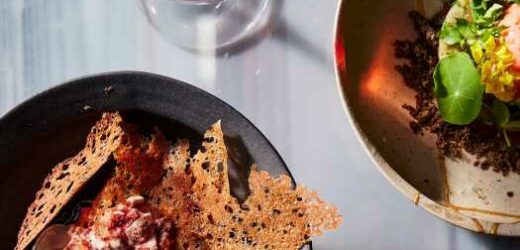The chef Yuji Tani has found another home for his precise cooking at this tasting-menu restaurant in the back of an industrial space in Greenpoint, Brooklyn.
House Brooklyn follows the original House in Tokyo.Credit…Nico Schinco for The New York Times
Supported by
Send any friend a story
As a subscriber, you have 10 gift articles to give each month. Anyone can read what you share.
By Pete Wells
In December, the chef Yuji Tani opened a second edition of the highly seasonal French-Japanese restaurant he owns in Tokyo. The original, now 15 years old, is called House. The new one, in Greenpoint, is House Brooklyn. For what it’s worth, neither House is in a house.
The first is in a black-glass cube in the Nishi-Azabu neighborhood. The newer House shares a reclaimed industrial space called 50 Norman with two other Japanese businesses. On the left is a shop that packs ready-to-brew dashi tea bags with a powder ground from cracked leathery mushrooms, stiff green panes of kelp, blank-eyed sardines and other things a retriever might get into on the beach at low tide. The shop’s dashi figures prominently in the traditional teishoku meal sets it serves.
On the right side of the building is an arts-and-crafts store where you can buy ceramic matcha bowls, delicate handblown glass bottles and a clear skateboard embedded with daisies.
House Brooklyn is all the way in the back. Behind its sliding doors and walls, Mr. Tani prepares dinner for no more than eight people at a time who watch him from a counter a few feet away.
At certain moments, the restaurant feels like a showroom for the arts-and-crafts store. All the plates and bowls are handmade by potters in Japan, as is an enormous vase in the kitchen that Mr. Tani fills with flowers and other cuttings he buys at the Greenmarket. At some point in the meal — just before a harissa-rubbed venison loin roasted inside a savoy cabbage leaf appears, say — diners are asked to choose a hand-forged knife. Some have handles made from cherry branches. The rest are attached to deer antlers.
In fact, none of the tableware at House Brooklyn is for sale. Mr. Tani gets the knives, plates and other items from his own network of artisans. When a plate breaks, he gives it to a kintsugi expert he knows in New York who will fit it back together with seams of silver lacquer.
Once all the diners are assembled, a manager will introduce the other servers, the two cooks and Mr. Tani. In the eight or so months that the restaurant has been in business, the staff has found a chatty, friendly tone, without being intrusive. They’re good at drawing the customers into conversations about the room, the cooking and the drinks — there are a few sakes that are rarely seen in New York along with natural wines, a genre Mr. Tani enjoys when he’s off duty. You don’t exactly feel as if you’re in Mr. Tani’s home, which I think is the intent, but at least there’s none of the stilted awkwardness that afflicts so many tasting-menu restaurants.
The meal will get underway with a mochi-wafer sandwich filled with foie gras mousse and cinnamon-spiced apples that are maybe a little too reminiscent of Thanksgiving pie. Then the cooking begins. One night in March, there was a charred length of leek, grilled to softness inside foil and brushed with a miso-egg yolk sauce; over the leek, Mr. Tani draped a thin sheet of just-seared Wagyu before sprinkling panko and bottarga over the whole thing.
In April, the leek was gone. In its place was a fat stalk of grilled white asparagus swabbed with shoyu koji and sprinkled with pistachios; the sauce was anchovy mayonnaise, newly whisked with enough yolks to turn it pale gold.
Mr. Tani cooks some Japanese fish that are rarely found outside sushi bars in New York City. He will gently torch the skin of toro sawara, the extra-fatty Japanese Spanish mackerel caught in winter, until its rich oils seep out. Anago, the conger eel that is more delicate than unagi, is made into an elegant grilled galantine, wrapped around burdock root and scallop mousse.
A galantine is obviously a French idea, but making it with grilled anago isn’t a simple substitution; it has a logic of its own, rooted in Japanese cooking. Sometimes you encounter attempts to fuse Japanese and French cuisine that never progress beyond obvious switcheroos, the one-from-column-A approach. You’ll get a Japanese dish recast with a French main ingredient, or the reverse. Through intuition or practice, Mr. Tani seems to think in both cuisines at once. I’m not sure where he got the idea of using cashew cream as a sauce for cabbage stuffed with almost-rare venison, but I know it’s one of the best dishes I’ve eaten this year.
Most of the courses change with the seasons, but two are locked in place. There will always be a salad of mozzarella and burrata dressed with olive oil, cassis syrup and pomegranate seeds, although what everybody remembers is the sweet, fragile strawberry tuile that covers the bowl like a lid, and shatters when tapped by a spoon.
The rice, baked in a black-enamel cast iron casserole with a whole or nearly whole lobe of foie gras, never leaves the menu, either. It’s impressive to look at — almost everybody takes a photo — and to eat. It’s mashed and stirred extensively before it’s served, leaving the foie gras in small, nearly invisible bits. You taste their memory.
A server may tell you that this dish did not come easily to Mr. Tani because he does not like foie gras. Plot twist, right? If he doesn’t like it, why does he serve it twice in a meal that can verge on being too long and filling? I am far from a foie gras hater, but I’d go without if that would bring the price of dinner down from $180 a person, before tax and all the rest.
I know this is a fantasy, like my long-held desire that cable companies and streaming services charge me by the hour. (I don’t watch much TV.) With tasting menus, you might pay more than the asking price, if, say, you spring for wine pairings. You’ll never pay less, though.
This stratum of the restaurant landscape is apparently unruffled by the economic palpitations of the past few years. There always seem to be enough people to fill the seats — House Brooklyn has been a tough reservation since it opened — so the business model must be working. But padding the menu with foie gras, Wagyu, caviar and other signifiers of luxury is at odds with Mr. Tani’s simple, unostentatious style. I can’t help thinking how nice it would be to have another House in Brooklyn with a shorter menu and lower prices. The cooking would be just as intuitive, fluid and impressionistic, if not more so. And more people would be able to enjoy it more often.
Follow New York Times Cooking on Instagram, Facebook, YouTube, TikTok and Pinterest. Get regular updates from New York Times Cooking, with recipe suggestions, cooking tips and shopping advice.
Site Index
Site Information Navigation
Source: Read Full Article



